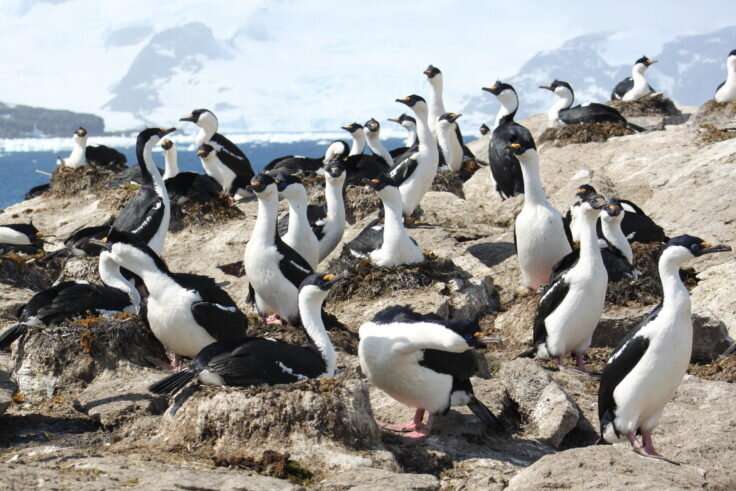Antarctic seabird faces declining populations

Data collected from a long-term study by British Antarctic Survey (BAS) scientists shows declining populations of an already relatively rare Antarctic seabird, the South Georgia shag. Published in the journal Polar Biology, a 40-year census from Signy Island in the remote South Orkney Islands and a 30-year census from Bird Island, close to the sub-Antarctic island of South Georgia, have shown significant population declines at both locations.
The Signy population has declined by more than a third of its previous size and the Bird Island population has more than halved. South Georgia shags are colonially-nesting seabirds and construct large, pedestal-shaped nests on cliffs. They lay up to three eggs annually and feed on a number of fish species which they catch by pursuit diving. This study confirms an ongoing long-term population decline in South Georgia shags of 41 percent at Signy since 1978 and almost 60 percent at Bird Island since 1989.
Operated by BAS, Signy Island Research Station is a summer-only station, and Bird Island Research Station is occupied by scientists all-year round. At both locations there are long-term monitoring programs on a number of seabird species, including penguins and albatrosses, as well as South Georgia shags.
Lead author and seabird ecologist Mike Dunn explained: "Identifying these declining population trends is essential for the effective future conservation of this species. The majority of the world population of South Georgia shags are located in the South Orkney islands and South Georgia, including Bird Island. Consequently, continuation of the declines shown in this study will be of important conservation concern."
Monitoring Antarctic seabird populations is an essential tool in helping scientists identify the processes driving not only variability in seabird abundance, but also wider changes in the Southern Ocean Ecosystem. The South Georgia shag population research at Signy and Bird Island provide a valuable context for other regional ecological research and are an important part of a wider program to understand how Antarctic animals respond to environmental change. The next challenge is to identify the factors driving these big population changes in these important seabird populations.
"Long term population size and trends of South Georgia Shags (Leucocarbo [atriceps] georgianus) at Signy Island, South Orkney Islands and Bird Island, South Georgia," by M.J. Dunn, S. Adlard, A.S. Lynnes, D. Fox, T.I. Morley, J.A. Jackson, is published in the journal Polar Biology.
More information: Michael J. Dunn et al, Long-term population size and trends of South Georgia Shags (Leucocarbo [atriceps] georgianus) at Signy Island, South Orkney Islands and Bird Island, South Georgia, Polar Biology (2021). DOI: 10.1007/s00300-021-02978-2
Provided by British Antarctic Survey





















